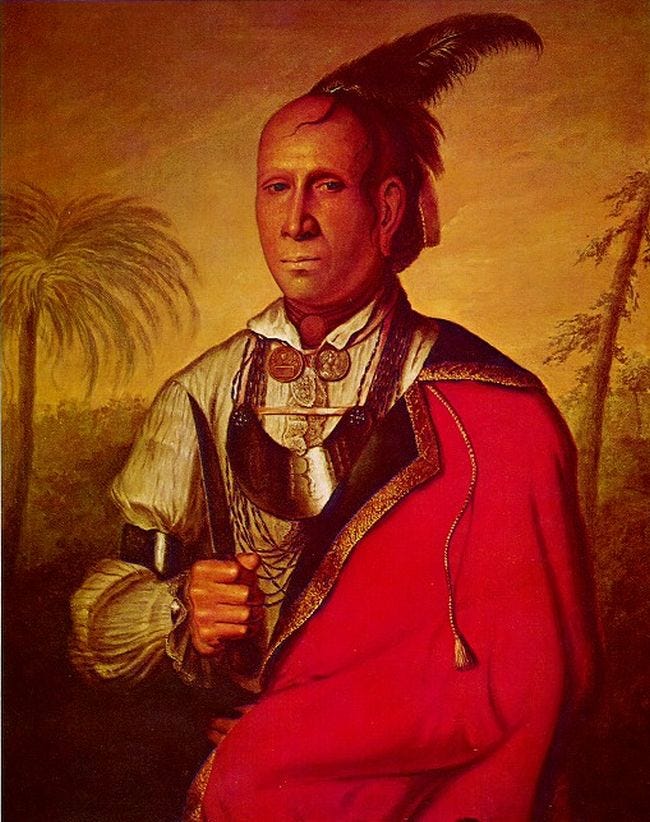The Revenge Of Chief Doublehead For The Killing Of His Brother Pumpkin Boy
And the fate of the last great Chickamauga chieftain, 1744-1807

“Invincible threat on the southern plain /
He walked with the thunder, wind and rain”
It is the opening couplet to the song “Doublehead” by the Pine Hill Haints, an Americana band based out of Savannah, Tennessee. Doublehead was the last great Chickamauga chief, a brother of Dragging Canoe and Standing Turkey. Doublehead lived on the southern bank of the Tennessee River near Savannah, across the state line, in what is now Alabama. His war was indeed brutal, a storm that ravaged the South before it became the South.
Human geography had been scrambled by the arrival of Europeans. Rather than a distinct tribe, the Chickamauga were a confederation of survivors. During the years before the American Revolution, when Dragging Canoe settled his band near the Chickamauga River, the whites called his diverse bands the ‘Chickamauga Cherokee’. Chief Doublehead too enjoyed “complete loyalty” from a motley collection of Lower Cherokee, Upper Creek, Chickasaw, Shawnee, Yuchi, and Delaware tribal remnants, along with mixed bloods and even some Scots-Irish settlers, at least two of whom married his sisters and provided vital trade contacts to the outside world.
It was a violent frontier, so leaders were expected to be violent. Doublehead “backed up his stature by vicious blood thirsty attacks on his enemies encroaching on his aboriginal hunting grounds and homelands,” Rickey Butch Walker writes.1 The great salt licks of central Tennessee drew abundant game, and Native Americans had taken seasonal hunts there since time immemorial, following game trails as old as the Pleistocene. “Many of Doublehead’s raids were actually hunting excursions where parties of Indians and settlers came in contact and fought. Therefore, many people killed were due to conflicts over hunting territory.” With the end of the American Revolution, and the withdrawal of the British allies of the Chickamauga, who had held back settlers from the frontier, those ancient game trails were now attracting a pent-up flood of immigrants.
Doublehead “is a man of small stature, compact and well formed, very dark skin, small piercing black eyes, the fixture of which when engaged in conversation are as immovable as diamonds set in metal and seem to indicate clearly that he comprehends the subject and in his reply to an address will omit nothing that has been said,” federal Indian agent Col. Return Jonathan Meigs wrote in 1805.2 “He is occasionally guilty of intemperance and then off his guard, and if he considers himself insulted the explosion of his passion resembles that of gunpowder.” Indeed, Doublehead was both impulsive and prone to extremes in his violence. He killed one of his many wives, a sister of one of Chief James Vann’s wives, in a fit of rage, inspiring the vendetta that would ultimately end him. Doublehead’s warpath left a trail of bodies and burned ‘stations’ across the southeast. “Doublehead was considered the most ruthless, brutal, violent, and blood thirsty Chickamauga warrior to ever live,” Walker writes. “Even though his nephew Robert Benge personally took 45 scalps, historians agree that Doublehead far surpassed that mark.”
Jamie Barrier, vocalist and guitarist for the Haints, is more poetic as he invents a revenge narrative for his subject. “It was when they burned alive an old medicine man / He took the tommy-hawk, raised his hand,” Barrier sings. Based on a conversation with Mr. Barrier some years ago, I conclude that he is relying on sketchy oral tradition right there, because I could not find such an account in primary sources. Doublehead did in fact exact a terrible revenge on his warpath, but not for the death of a medicine man. Katie Barrier, Jamie’s wife, plays the washboard thimble on this track. Ben Ryan is playing a snare drum and Matt Bakula made the washtub bass rhythm. (I can’t recall who played the accordian and I don’t have liner notes available.) The Pine Hill Haints are an amazing band, capable of winning over multiple generations of one family at a single concert. You almost never see that sort of uniting, four-quadrant performance anymore: kids, teens, adults, and seniors all love to watch the Haints together.
Here is the song. My telling of the true story of Chief Doublehead, bloody warlord of the early American frontier, as well as analysis of the historicity of this song, is below.
Keep reading with a 7-day free trial
Subscribe to Polemology Positions to keep reading this post and get 7 days of free access to the full post archives.

